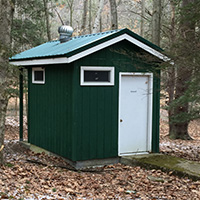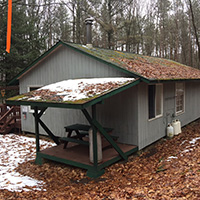
Gleason Audubon Wildlife Sanctuary
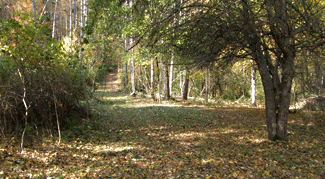
The Gleason Audubon Wildlife Sanctuary is a diverse 35-acre wildlife preserve in the Town of Caton, Steuben County, New York. This preserve was acquired in 1989 with a bequest from the estate of long-time Chemung Valley Audubon Society (CVAS) members, Herbert and Virginia Gleason.
This property is predominately forested, and a system of trails passes through groves of hemlocks, pines, and northern hardwoods. A pond and small intermittent streams enhance the property’s value to plants and animals. The elevation of this sanctuary is 1,650 feet and has alluvial soils in the Lordstown and Mardin soil series.
CVAS has a cabin on the property available for CVAS member use only. Trails are open to the public during daylight hours.
Audubon protects valuable habitats and the birds that depend on them: Important Bird Areas (IBA). Find IBAs in our area at Audubon.org.
Location
11523 Kelly Hill Road, Caton, New York | Approximately a 20-minute drive either from Corning or Elmira. Maps of this location can be viewed here and here.
Directions
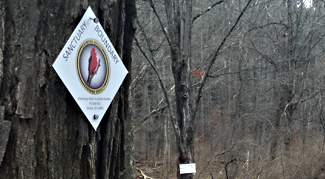
From Corning, take Route 225 to Caton. At the main intersection in Caton, go straight onto Marsh Road (Route 32) and stay on Marsh Road to the end. Turn left following Route 32. In 3.5 miles turn right on to Birch Creek Road. Follow Birch Creek Road for one mile and bear left onto Hamilton Road. Stay on Hamilton Road to the end (0.8 mile). Turn right on to Kelly Hill Road. Proceed approximately one mile passing houses and then entering a wooded area. The road goes downhill and at the bottom of the hill, the sanctuary entrance is on the right. The Gleason Audubon Wildlife Sanctuary sign can be seen from the road on a maple tree as you look down the driveway. Please park along the side of the road.
 From Elmira, follow Route 328 South to Sagetown Road. Turn right onto Sagetown Road and after you cross the Steuben County line, watch for a Town of Caton sign. In as short distance, turn left onto Birch Creek Road. Follow Birch Creek Road for 1 mile and bear left onto Hamilton Road. Stay on Hamilton Road to the end (0.8 mile). Turn right on to Kelly Hill Road. Proceed approximately one mile passing houses and then entering a wooded area. The road goes downhill and at the bottom of the hill, the sanctuary entrance is on the right. The Gleason Audubon Wildlife Sanctuary sign can be seen from the road on a maple tree as you look down the driveway. (If you pass the driveway and come out to State Line Road (PA-NY border) you have gone too far). Please park along the side of the road.
From Elmira, follow Route 328 South to Sagetown Road. Turn right onto Sagetown Road and after you cross the Steuben County line, watch for a Town of Caton sign. In as short distance, turn left onto Birch Creek Road. Follow Birch Creek Road for 1 mile and bear left onto Hamilton Road. Stay on Hamilton Road to the end (0.8 mile). Turn right on to Kelly Hill Road. Proceed approximately one mile passing houses and then entering a wooded area. The road goes downhill and at the bottom of the hill, the sanctuary entrance is on the right. The Gleason Audubon Wildlife Sanctuary sign can be seen from the road on a maple tree as you look down the driveway. (If you pass the driveway and come out to State Line Road (PA-NY border) you have gone too far). Please park along the side of the road.
Trails
Trails are open for public use for hiking, birding, and cross country skiing. Hunting, trapping, and motorized vehicles are prohibited.
Follow the main roadway from the entrance that will lead past the cabin to a pond. From the dam, trails will branch off. Currently trails are being constructed, but once built, just follow trail markers painted on the trees.
Google Map for The Gleason Audubon Sanctuary
Gleason Pollinator Garden & Cabin Improvement Project
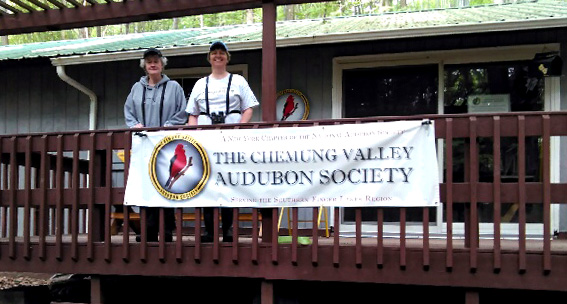
In 2021, Mary Jane and Brian Dugan began installing pollinator gardens at the Gleason Audubon Wildlife Sanctuary in October this year. We have some before pictures (here>, here, and here) and look forward to showing the "after" pictures in the summer!
If you've ever had the pleasure of exploring our Northrup Hill or Gleason Sanctuaries, you may know that the Chemung Valley Audubon Society has a cabin in the Gleason Audubon Wildlife Santuary in Caton, NY, that has been used by the club for events over the years. The Ondura roof, installed over thirty years ago, was deteriorating, thereby allowing water to enter and damage the interior structure.
Recognizing the seriousness of this problem, the CVAS Board of Directors hired RJ Construction of Woodhull, NY, to re-roof the cabin with a 40-year-warranty metal roof. A green roof color was selected to blend in with the forest environment of the sanctuary. The roofing work was initiated on Wednesday, March 28, 2018, and completed on Saturday, March 31, 2018.
Once the old roofing material was removed, an inspection of the main structure found it to be in excellent condition. As part of the new roof, translucent panels were placed strategically in the roof, allowing sunlight to penetrate into the cabin and brighten up the room. The construction went very well, and CVAS members are very pleased with the work. It looks great!
Do visit Gleason for a nice walk on our trails and see the progress of ongoing improvements to the cabin!
More Images of the Sanctuary
Click on a thumbnail to view a larger version in a new window.
Gleason Bird Walk and Trail Work
Members of the Chemung Valley Audubon Society chapter met on Saturday, October 13, 2018, for a walk and work party at the Gleason Audubon Wildlife Sanctuary. The morning started with a pleasant bird walk along existing trails and a break for coffee and donuts at the cabin, followed by some trail work.
After a hearty picnic lunch, the group explored the new trails being mapped on the property, performing light trail work along the way. We all agreed that the highlight of the day was the variety and quantity of mushrooms and fungi found throughout the property. The unusually wet conditions that late summer and early fall had resulted in an extraordinary show of fungus.
Below, we've posted some pictures of the beauty from that bird walk and later ones.
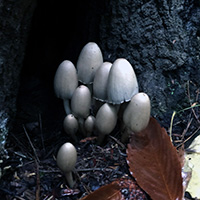 © Don Hall |
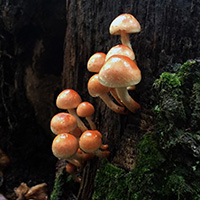 © Don Hall |
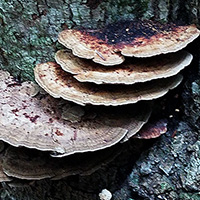 © Martin van der Grinten |
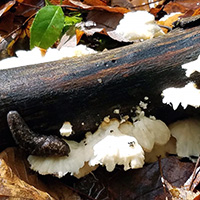 © Martin van der Grinten |
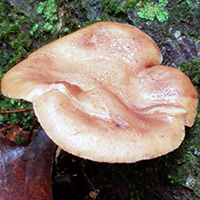 © Martin van der Grinten |
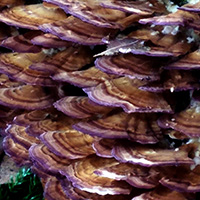 © Martin van der Grinten |
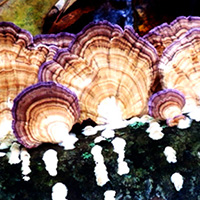 © Martin van der Grinten |
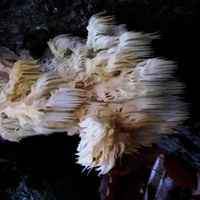 © Martin van der Grinten |
 |
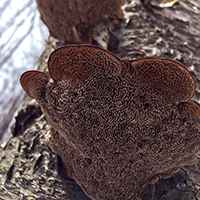 |
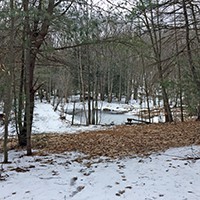 |
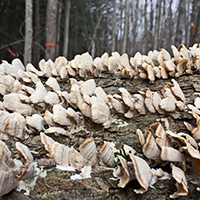 |
 |
 |
 |
 |
 |
 |
 |
 |
Birds Recorded at the Sanctuary
For a description of each of these birds, please visit the Audubon Field Guide.
| American Crow | American Goldfinch | American Robin |
| Barred Owl | Belted Kingfisher | Blackburnian Warbler |
| Black-Capped Chickadee | Blackpoll Warbler | Black-Throated Blue Warbler |
| Black-Throated Green Warbler | Blue Jay | Blue-Headed Vireo |
| Blue-Winged Warbler | Boblink | Brown Creeper |
| Brown-Headed Cowbird | Canada Goose | Chipping Sparrow |
| Common Grackle | Common Raven | Common Yellowthroat |
| Dark-Eyed Junco | Downy Woodpecker | Eastern Phoebe |
| Eastern Screech-Owl | Eastern Towhee | Eastern Wood Pewee |
| Field Sparrow | Golden-Crowned Kinglet | Gray Catbird |
| Great Blue Heron | Great Crested Flycatcher | Great Horned Owl |
| Hairy Woodpecker | Hermit Thrush | House Finch |
| House Wren | Indigo Bunting | Killdeer |
| Least Flycatcher | Magnolia Warbler | Mourning Dove |
| Northern Cardinal | Northern Flicker | Northern Parula |
| Northern Saw-Whet Owl | Ovenbird | Philadelphia Vireo |
| Pileated Woodpecker | Prairie Warbler | Purple Finch |
| Red-Breasted Nuthatch | Red-Eyed Vireo | Red-Winged Blackbird |
| Rose-Breasted Grosbeak | Ruby-Crowned Kinglet | Ruffed Grouse |
| Scarlet Tanager | Solitary Sandpiper | Song Sparrow |
| Tufted Titmouse | Veery | White-Breasted Nuthatch |
| White-Throated Sparrow | Wild Turkey | Wilson’s Warbler |
| Wood Duck | Wood Thrush | Yellow-Bellied Sapsucker |
| Yellow-Rumped Warbler |
Plants Recorded at the Sanctuary
The following list of plants recorded at the sanctuary was compiled by Alex Petzke.
| Taxonomic Name | Common Name | Native (N) or Exotic/Introduced (E) |
|---|---|---|
| Acer pensylvanicum | Striped Maple | N |
| Acer rubrum | Red Maple | N |
| Acer saccharum | Sugar Maple | N |
| Achillea millefolium | Common Yarrow | N |
| Alliaria petiolata | Garlic Mustard | E |
| Ambrosia artemisiifolia | Common Ragweed | N |
| Arisaema triphyllum | Jack-in-the-Pulpit | N |
| Athyrium angustum | Northern Lady Fern | N |
| Betula lenta | Black Birch | N |
| Bidens cernua | Nodding Beggar Ticks | N |
| Bidens frondosa | Devil's Beggar Ticks | N |
| Brachyelytrum sp. | Shorthusk Grass | N |
| Cardamine pensylvanica | Pennsylvania Bittercress | N |
| Chelone glabra | White Turtlehead | N |
| Cirsium vulgare | Bull Thistle | E |
| Corallorhiza maculata | Spotted Coralroot | N |
| Dennstaedtia punctilobula | Hay-Scented Fern | N |
| Dryopteris intermedia | Evergreen Wood Fern | N |
| Epifagus virginiana | Beechdrops | N |
| Erigeron annuus | Annual Daisy Fleabane | N |
| Eurybia divaricata | White Wood Aster | N |
| Euthamia graminifolia | Common Flat-Topped Goldenrod | N |
| Fagus grandifolia | Fagus Grandifolia | N |
| Fragaria virginiana | Wild Strawberry | N |
| Fraxinus americana | White Ash | N |
| Fraxinus pennsylvanica | Green Ash | N |
| Galeopsis sp. | Hemp Nettle | E |
| Galium lanceolatum | Wild Licorice | N |
| Galium triflorum | Sweet-Scented Bedstraw | N |
| Geranium robertianum | Herb Robert | N |
| Impatiens capensis | Orange Jewelweed | N |
| Lobelia inflata | Indian Tobacco | N |
| Ludwigia palustris | Water Purslane | N |
| Lysimachia borealis | Starflower | N |
| Maianthemum canadense | Canada Mayflower | N |
| Mitchella repens | Partridge Berry | N |
| Oclemena acuminata | Whorled Wood Aster | N |
| Onoclea sensibilis | Sensitive Fern | N |
| Osmunda claytoniana | Interrupted Fern | N |
| Persicaria sagittata | Arrow-Leaved Tearthumb | N |
| Phytolacca americana | Pokeweed | N |
| Pinus resinosa | Red Pine | N |
| Pinus strobus | Eastern White Pine | N |
| Plantago rugelii | Rugel's Plaintain | N |
| Populus grandidentata | Bigtooth Aspen | N |
| Potamogeton epihydrus | Ribbon-Leaved Pondweed | N |
| Pteridium aquilinum | Bracken Fern | N |
| Quercus alba | White Oak | N |
| Quercus rubra | Northern Red Oak | N |
| Rhus typhina | Staghorn Sumac | N |
| Rubus allegheniensis | Common Blackberry | N |
| Sassafras albidum | Sassafras | N |
| Scutellaria lateriflora | Mad Dog Skullcap | N |
| Smilax hispida | Bristly Greenbrier | N |
| Solidago caesia | Blue-Stemmed Goldenrod | N |
| Solidago gigantea | Swamp Goldenrod | N |
| Stellaria media | Common Chickweed | E |
| Solidago rugosa | Wrinkle-Leaved Goldenrod | N |
| Thuidium delicatulum | Common Fern Moss | N |
| Tsuga canadensis | Eastern Hemlock | N |
| Verbena urticifolia | White Vervain | N |
| Viburnum acerifolium | Maple-Leaved Viburnum | N |
| Vitis riparia | River Grape | N |
